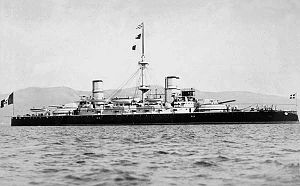Italian battleship Sardegna

Sardegna
|
|
| History | |
|---|---|
|
|
|
| Name: | Sardegna |
| Namesake: | Sardinia |
| Builder: | La Spezia Naval Shipyard |
| Laid down: | 24 October 1884 |
| Launched: | 20 September 1890 |
| Completed: | 16 February 1895 |
| Struck: | 4 January 1923 |
| General characteristics | |
| Class and type: | Re Umberto-class ironclad battleship |
| Displacement: |
|
| Length: | 428 ft 10.5 in (130.7 m) |
| Beam: | 76 ft 10.5 in (23.4 m) |
| Draft: | 29 ft (8.8 m) |
| Installed power: |
|
| Propulsion: | 2 shafts, vertical triple expansion steam engines |
| Speed: | 20.3 knots (37.6 km/h; 23.4 mph) |
| Range: | 4,000–6,000 nmi (7,408–11,112 km) at 10 knots (19 km/h; 12 mph) |
| Complement: | 794 |
| Armament: |
|
| Armor: |
|
Sardegna was the third of three Re Umberto-class ironclad battleships built for the Italian Regia Marina (Royal Navy). The ship, named for the island of Sardinia, was laid down in La Spezia in October 1885, launched in September 1890, and completed in February 1895. She was armed with a main battery of four 13.5-inch (340 mm) guns and had a top speed of 20.3 knots (37.6 km/h; 23.4 mph)—albeit at the cost of armor protection–and she was one of the first warships to be equipped with a wireless telegraph.
Sardegna spent the first decade of her career in the Active Squadron of the Italian fleet. Thereafter, she was transferred to the Reserve Squadron, and by 1911, she was part of the Training Division. She took part in the Italo-Turkish War of 1911–12, where she escorted convoys to North Africa and supported Italian forces ashore by bombarding Ottoman troops. During World War I, Sardegna served as the flagship of the naval forces defending Venice against a possible attack from the Austro-Hungarian Navy, which did not materialize. After the city became threatened following the Battle of Caporetto in November 1917, the ship was withdrawn to Brindisi and later Taranto, where she continued to serve as a guard ship. She took part in Allied operations in Turkey in 1919–22, and after returning to Italy in 1923, she was broken up for scrap.
Sardegna was 130.73 meters (428.9 ft) long overall; she had a beam of 23.44 m (76.9 ft) and an average draft of 8.84 m (29.0 ft). She displaced 13,641 metric tons (13,426 long tons; 15,037 short tons) normally and up to 15,426 t (15,182 long tons; 17,004 short tons) at full load. Her propulsion system consisted of a pair of triple-expansion steam engines, each driving a single screw propeller, with steam supplied by eighteen coal-fired, cylindrical fire-tube boilers. She was the first Italian warship to be equipped with triple expansion engines. Her propulsion system produced a top speed of 20.3 knots (37.6 km/h; 23.4 mph) at 22,800 indicated horsepower (17,000 kW). Specific figures for her cruising radius have not survived, but the ships of her class could steam for 4,000 to 6,000 nautical miles (7,400 to 11,100 km; 4,600 to 6,900 mi) at a speed of 10 knots (19 km/h; 12 mph). She had a crew of 794 officers and men. Sardegna was one of the first warships equipped with Marconi's new wireless telegraph.
...
Wikipedia
